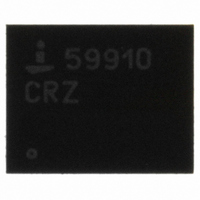ISL59910IRZ Intersil, ISL59910IRZ Datasheet - Page 9

ISL59910IRZ
Manufacturer Part Number
ISL59910IRZ
Description
IC RCVR/EQUALZR TRPL DIFF 28-QFN
Manufacturer
Intersil
Type
Receiverr
Datasheet
1.ISL59910IRZ.pdf
(12 pages)
Specifications of ISL59910IRZ
Number Of Drivers/receivers
0/3
Protocol
Twisted-Pair
Voltage - Supply
5V
Mounting Type
Surface Mount
Package / Case
24-VQFN Exposed Pad, 24-HVQFN, 24-SQFN, 24-DHVQFN
Lead Free Status / RoHS Status
Lead free / RoHS Compliant
Available stocks
Company
Part Number
Manufacturer
Quantity
Price
Company:
Part Number:
ISL59910IRZ
Manufacturer:
Intersil
Quantity:
78
Company:
Part Number:
ISL59910IRZ
Manufacturer:
Nuvoton
Quantity:
482
Part Number:
ISL59910IRZ
Manufacturer:
INTERSIL
Quantity:
20 000
Company:
Part Number:
ISL59910IRZ-T7
Manufacturer:
INTERSIL
Quantity:
1 000
Part Number:
ISL59910IRZ-T7
Manufacturer:
INTERSIL
Quantity:
20 000
Typical Performance Curves
Applications Information
Logic Control
The ISL59913 has two logical input pins, Chip Enable
(ENABLE) and Switch Gain (X2). The logic circuits all have a
nominal threshold of 1.1V above the potential of the logic
reference pin (VREF). In most applications it is expected that
this chip will run from a +5V, 0V, -5V supply system with logic
being run between 0V and +5V. In this case the logic
reference voltage should be tied to the 0V supply. If the logic
is referenced to the -5V rail, then the logic reference should
be connected to -5V. The logic reference pin sources about
60µA and this will rise to about 200µA if all inputs are true
(positive).
The logic inputs all source up to 10µA when they are held at
the logic reference level. When taken positive, the inputs
sink a current dependent on the high level, up to 50µA for a
high level 5V above the reference level.
The logic inputs, if not used, should be tied to the
appropriate voltage in order to define their state.
Control Reference and Signal Reference
Analog control voltages are required to set the equalizer and
contrast levels. These signals are voltages in the range
0V to 1V, which are referenced to the control reference pin. It
is expected that the control reference pin will be tied to 0V
and the control voltage will vary from 0V to 1V. It is; however,
acceptable to connect the control reference to any potential
between -5V and 0V to which the control voltages are
referenced.
The control voltage pins themselves are high impedance.
The control reference pin will source between 0µA and
200µA depending on the control voltages being applied.
FIGURE 23. PACKAGE POWER DISSIPATION vs AMBIENT
4.5
3.5
2.5
1.5
0.5
4
3
2
1
0
0
JEDEC JESD51-7 HIGH EFFECTIVE THERMAL
CONDUCTIVITY TEST BOARD - QFN EXPOSED
DIEPAD SOLDERED TO PCB PER JESD51-5
3.378W
TEMPERATURE
25
AMBIENT TEMPERATURE (°C)
50
9
75
85
100
(Continued)
125
ISL59910, ISL59913
150
The control reference and logic reference effectively remove
the necessity for the 0V rail and operation from ±5V (or 0V
and 10V) only is possible. However we still need a further
reference to define the 0V level of the single ended output
signal. The reference for the output signal is provided by the
0V pin. The output stage cannot pull fully up or down to either
supply so it is important that the reference is positioned to
allow full output swing. The 0V reference should be tied to a
'quiet ground' as any noise on this pin is transferred directly to
the output. The 0V pin is a high impedance pin and draws DC
bias currents of a few µA and similar levels of AC current.
Equalizing
When transmitting a signal across a twisted pair cable, it is
found that the high frequency (above 1MHz) information is
attenuated more significantly than the information at low
frequencies. The attenuation is predominantly due to resistive
skin effect losses and has a loss curve which depends on the
resistivity of the conductor, surface condition of the wire and the
wire diameter. For the range of high performance twisted pair
cables based on 24awg copper wire (CAT-5 etc). These
parameters vary only a little between cable types and in general
cables exhibit the same frequency dependence of loss. (The
lower loss cables can be compared with somewhat longer
lengths of their more lossy brothers.) This enables a single
equalizing law equation to be built into the ISL59913.
With a control voltage applied between pins VCTRL and
VREF, the frequency dependence of the equalization is
shown in Figure 8. The equalization matches the cable loss
up to about 100MHz. Above this, system gain is rolled off
rapidly to reduce noise bandwidth. The roll-off occurs more
rapidly for higher control voltages, thus the system (cable +
equalizer) bandwidth reduces as the cable length increases.
This is desirable, as noise becomes an increasing issue as
the equalization increases.
FIGURE 24. PACKAGE POWER DISSIPATION vs AMBIENT
1.2
0.8
0.6
0.4
0.2
1
0
0
JEDEC JESD51-3 LOW EFFECTIVE THERMAL
CONDUCTIVITY TEST BOARD
893mW
TEMPERATURE
25
AMBIENT TEMPERATURE (°C)
50
75
85
100
125
December 15, 2006
150
FN6406.0












